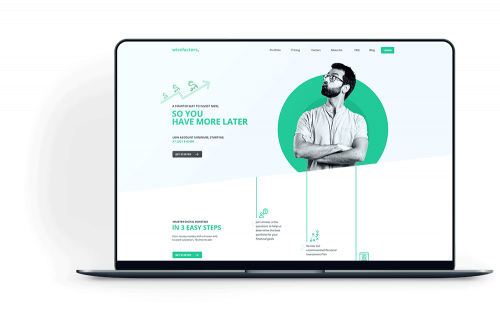The Ultimate Overview to Modern Web Site Style Trends
In the ever-evolving electronic landscape, contemporary website design fads play a crucial duty in forming user experience and engagement. From the surge of minimal design concepts that focus on simplicity to the effect of vibrant typography in specifying brand identity, each aspect adds to a cohesive online existence.
Minimalist Style Principles
Minimalist design principles stress the concept that much less is more, supporting for simpleness and performance in aesthetic interaction. This method strips away unneeded components, focusing rather on crucial elements that share the desired message effectively. By focusing on clarity, minimalist design improves customer experience, allowing site visitors to navigate web sites easily.
Core tenets of minimal style consist of the use of sufficient white area, which produces a sense of balance and company. This negative room not only guides the audience's focus to crucial elements however likewise cultivates a relaxing visual environment. In addition, a minimal color combination is commonly employed, making use of soft colors or single schemes to preserve aesthetic cohesion and prevent overwhelming the customer.
Typography plays a critical function in minimalist design, where legible typefaces are picked for their simpleness and performance in communicating material. Images and graphics are conserved, guaranteeing that they serve a function as opposed to distract from the general message. Ultimately, minimal layout concepts cultivate a focused environment that urges users to involve with the material, boosting the general performance of modern website design. This pattern mirrors an expanding appreciation for thoughtful, user-centric looks in electronic areas.
Vibrant Typography Choices
Welcoming strong typography selections has actually ended up being a specifying attribute of contemporary web site layout, as it efficiently catches focus and communicates solid messaging. Developers are increasingly making use of typography not merely as a functional component but as a vital aesthetic part that boosts the overall visual and customer experience.

Furthermore, the association of bold typography with minimalist design principles permits striking contrasts, enhancing readability while keeping visual allure. Using whitespace around strong text additionally highlights its importance, making sure that the message resonates with the audience.
As electronic landscapes end up being more competitive, leveraging vibrant typography makes it possible for brand names to separate themselves and leave a long lasting perception. The careful choice of typefaces and their application can stimulate emotions, develop tone, and drive action, making bold typography an indispensable device in contemporary site layout. Inevitably, it is a powerful way to improve storytelling and make sure that crucial messages are not only seen however likewise really felt.
Responsive and Mobile-first Design
Mobile-first and receptive design has become an essential principle in contemporary site growth, mirroring the enhancing dependence on mobile devices for accessing on-line material. As customer habits shifts towards mobile browsing, developers should focus on creating experiences that adapt perfectly across various display dimensions and resolutions.
A receptive design guarantees that an internet site automatically changes its format, images, and functionality based on the device being used. Mobile-first design advocates for developing sites at first for smaller sized displays, ultimately scaling up to bigger screens.
Implementing mobile-first and responsive concepts not only accommodates user preferences however additionally lines up with search engine optimization (SEARCH ENGINE OPTIMIZATION) techniques. Significant search engines, like Google, prioritize mobile-friendly web sites in their positions, making it vital for businesses to embrace these layout strategies. In an affordable digital landscape, embracing mobile-first and responsive design is not just an alternative; it is crucial for making sure access and interaction with a diverse audience.
Involving Microinteractions
Microinteractions play a critical role in improving individual engagement and total internet site experience, specifically in the context of mobile-first and responsive style. These subtle layout aspects give instant responses to individuals, making interactions a lot more user-friendly and pleasurable. Instances include switch computer animations, notification signals, and filling indicators, which not just guide users but also produce a feeling of link with the user interface.
Incorporating interesting microinteractions can dramatically improve usability by decreasing cognitive load. When individuals obtain acoustic or visual feedback upon doing actions, such as clicking a button or submitting a kind, they feel more certain in their choices. This fosters a smoother navigating experience, eventually boosting customer retention.

As internet site design patterns remain to evolve, the importance of microinteractions can not be overemphasized. They function as the subtle yet powerful touchpoints that transform ordinary communications right into amazing experiences, therefore elevating the general effectiveness of modern website design.
Sustainable Website Design Practices
Sustainable internet style methods are coming to be increasingly crucial as the electronic landscape grows and environmental article worries climb. Developers and developers are acknowledging their obligation to produce web sites that not only offer individual needs but also decrease ecological influence. This method includes several crucial approaches.
To start with, optimizing power consumption is extremely important. Sites should be designed to load quickly and successfully, which minimizes web server power usage and improves individual experience. Techniques such as photo compression, lessening HTTP demands, and utilizing modern coding methods contribute dramatically to this goal.
Secondly, choosing eco-friendly organizing companies is crucial - website design. Numerous holding companies are now powered by renewable resource resources, enabling sites to operate in a more sustainable way. This selection mirrors a dedication to go to website decreasing carbon impacts
Moreover, adopting a minimalist design can enhance sustainability. Fewer components on a page lead to much less information transfer, which not only quickens filling times yet also conserves resources.
Finally, promoting digital accessibility makes certain that websites get to a bigger audience without unneeded bloat, aligning individual experience with ecological responsibility. By integrating these sustainable techniques, web designers can contribute positively to both customer engagement and the earth's health.
Verdict
In recap, contemporary web site layout patterns highlight the assimilation of minimalist concepts, bold typography, and responsive style to boost customer experience. Engaging microinteractions add to remarkable interactions, while sustainable methods support for eco aware advancement. Collectively, these components not just boost aesthetic appeal but also improve functionality, ensuring that internet sites are both user-friendly and visually striking. explanation Taking on these trends is essential for producing impactful digital experiences that reverberate with users in an increasingly competitive online landscape.
In the ever-evolving digital landscape, contemporary web site style trends play an essential role in shaping user experience and interaction. By focusing on quality, minimal style enhances individual experience, enabling site visitors to navigate websites effortlessly.
Inevitably, minimal layout concepts grow a focused environment that motivates users to engage with the content, improving the overall performance of modern site style.Microinteractions play a pivotal role in boosting individual involvement and general site experience, particularly in the context of receptive and mobile-first style.In recap, modern web site design patterns emphasize the assimilation of minimalist principles, vibrant typography, and responsive design to boost individual experience.